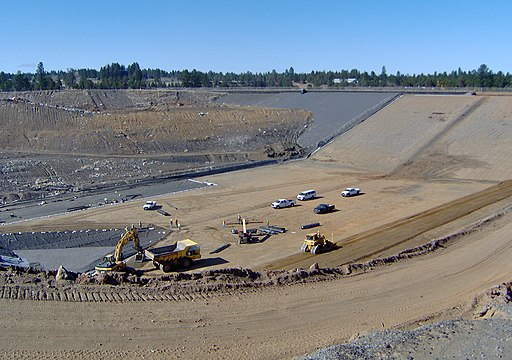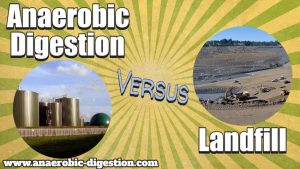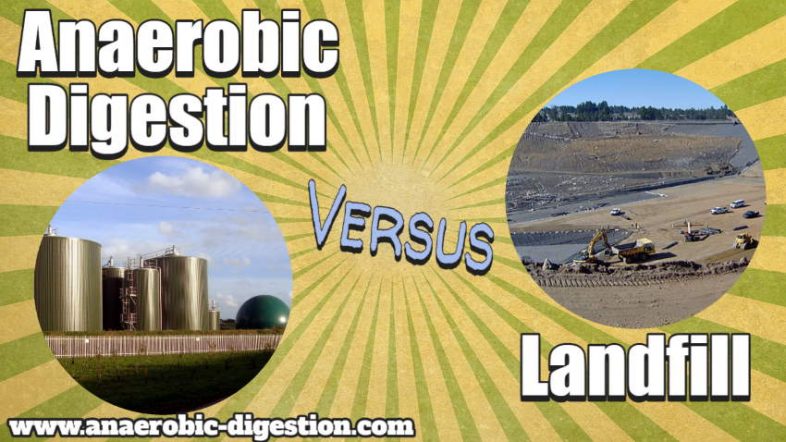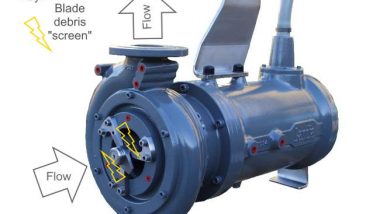Assessing the advantages of anaerobic digestion vs landfill as a means of disposing organic waste is an important step.
Businesses need to know for sure that if they move from landfill to anaerobic digestion as the means of disposal of their waste there are not known issues which may prove a risk to the reputation of their organisation.
Members of the public who spend a lot of their time each day separating their kitchen waste, putting it in a caddie and leaving their food scraps out for their council's kerbside collection, also need to know that their efforts are worthwhile.
If you are one of those, read-on because we are about to answer your question! If not, and your motive for seeking this article out is other than mentioned above, keep reading as well! The answer is most likely, also here.
Anaerobic Digestion vs Landfill for Waste Disposal
The starting point for the comparison of Anaerobic Digestion vs Landfill is the assumption that an individual/ organisation has organic waste (biological waste or waste biomass) which needs to be disposed of responsibly. Many people simply wish to “get rid of” their waste as cheaply as possible, but by asking this question, it implies that the enquirer accepts that they have a social responsibility to use the best method.
In this article our assumption is that the “best” method of waste disposal (getting rubbish taken away and out of sight) also includes doing it in a sustainable way from the point of view of avoiding as far as possible:
- causing a risk of environmental harm to the local environment, and
- minimising carbon emissions in the light of climate change as witnessed by rising temperatures and extreme weather conditions (as occurred in 2019 and to a lesser extent in the preceding years).
Now, let's consider both anaerobic digestion and landfill as waste disposal methods separately.
Having clarified both as waste management techniques we will provide our comparison of these two very different methods, and give our opinion on which is “best”.
First, it is necessary to understand the basics of the anaerobic digestion process:
What Happens to Waste During Anaerobic Digestion
Organic waste which can range from inedible food (food waste) to cow manure, out-of-specification food crops to chicken feathers, can all be suitable for disposal by fermentation in the anaerobic digestion (AD) process. The AD process is simply controlled “rotting” (decomposition) without air.
This incidentally also produces an energy output in the from of “biogas”. The biogas is sold for profit, or used to make electricity which when not needed to power the plant, is also sold.
This provides a very important environmental benefit because biogas is a renewable energy source. In fact, a well-run AD facility can be a net-negative carbon emitter, putting back carbon into the soil each year where it will stay, and replacing fossil fuel use. In other words, anaerobic digestion can ultimately help reverse greenhouse gas emissions.
Disposal of the waste is also achieved during anaerobic digestion. Some of the waste mass (carbon and hydrogen (CH4) is converted to methane during the process. This is called “mass destruction” in the waste industry. What remains is converted to simpler substances after the cell walls of plant matter are ruptured.
These simpler (shorter chain molecules) are the building blocks of biology. Unsurprisingly, they can be used as a natural fertiliser (subject to human health safety controls) and soil improver.
In addition to liquid fertiliser, anaerobic digestion process output (digestate) occurs in the form of a solid phase. The digester output of solids comprises fibres, husks etc., and a small proportion of inert material, plus unwanted contaminants such as plastic materials.
Subject to compliance with regulatory removal of unwanted contaminants, and public health related regulatory compliance, the ultimate destination (disposal point) for anaerobic digestion residues is onto land for a beneficial use (e.g. a fertiliser). When this is coupled with an agricultural spreading plan to avoid build-up of certain chemicals, this form of disposal can continue for an indefinite period on the same land. Thus waste disposal via anaerobic digestion is classed as a long-term sustainable form of waste disposal.
Recycling takes place on two levels during anaerobic digestion. The production of biogas which recycles energy as the first level. The remaining liquid and fibre output (digestate) recycles the fertilising materials which new crops need to grow healthily.
What Happens to Waste When Placed in a Landfill

Waste is usually pre-sorted for recyclable materials before it is dumped in a landfill and the organic content may be removed, but this is rare. In general, only the valuable materials in solid waste, such as metals (e.g. iron, copper, tin etc), paper, and glass are removed before tipping in a landfill.odern landfills are designed to be lined and capped and to subject the environment to the minimum actual harm, and risk of harm through pollution of their surroundings, as possible.
Paradoxically, this practise also creates conditions in the waste where uncontrolled anaerobic digestion occurs, producing landfill gas (a biogas – but not so clean as AD plant biogas). The biogas can, and usually is collected and used. But the proportion of the biogas collected over the long lifetime in which an old landfill produces biogas, is seldom above 60%.
The nutrients that remain, far from being usable as a fertiliser contain many contaminants which for a well-controlled landfill may not be inherently toxic in themselves are at very high strengths. The high strength “leachate” results in a highly toxic effect should the ever be a leak.
Of course, there will be leaks to all landfill membrane containment systems. Nothing lasts forever, and even if the materials used to hold the leachate inside didn't deteriorate geological changes will occur. Through erosion, earthquakes, and other effects the earth's crust never stops being modified.
So, those are the fates of waste materials when subjected to the anaerobic digestion process, and for all rubbish ‘disposed” to landfill.
A comparison of Anaerobic Digestion vs Landfill
The important differences between anaerobic digestion and landfill follow:
1. “Treatment” versus “Hiding Out of Sight”
 Anaerobic digestion treats waste. It converts the waste into a form which can be used again. It is a form of recycling in which the original chemicals in plant matter (organic chemicals as well as mineral-based compounds) are decomposed and become available to provide for re-growth of a next generation of plants.
Anaerobic digestion treats waste. It converts the waste into a form which can be used again. It is a form of recycling in which the original chemicals in plant matter (organic chemicals as well as mineral-based compounds) are decomposed and become available to provide for re-growth of a next generation of plants.
Landfill, while a form of slow anaerobic digestion does occur within them, is mostly a form of entombment. The trash is effectively hidden under a restored surface such as grassland or a park. Where it works well, our old possessions may well still be there for future archaeologists to dig-up in 2,000 or even 3,000 years time.
Where landfill doesn't work well, the linings will cease to contain the leachate, and the landfill gas will escape. The leachate will contaminate the subterranean water and render wells undrinkable for future generations. The gas will cause a risk of explosions as it escapes, and when it gets into the atmosphere continue to cause even further global warming than current predictions allow for.
2. The Need for Ever More Space for Landfills
The anaerobic digestion process needs no more space than the footprint of the tanks and equipment, plus short-term storage bays for the incoming waste. There is no additional land needed no matter how long the biogas facility will continue to operate.
Landfill constantly fills up huge void spaces. Land area is finite, and suitable land for landfilling only a small proportion of all available land. As cities become larger and are intensively developed waste has to be transported ever further out to where new landfill space can be created. Costs rise while this is possible, but in some countries they are already unable to find suitable land for new landfills.
3. The Need for Ever More Resources to Replace Materials Placed in Landfills
Anaerobic digestion is a mainly resource neutral process, and is based upon recycling the same mineral and organic resources time and again with no end-point.
The consequence of landfilling is the need to constantly replenish the materials placed in them, with new materials constantly to be won from the ground quarries multiply. But mineral resources are finite. They become progressively harder to find, and need more energy to extract the lower grade minerals.
Just as far the landfills themselves the available land will inevitably run out.
Anaerobic Digestion vs Landfill – The Verdict
Anaerobic digestion technology is not yet fully developed and far from perfect as a recycling method. It is in general more expensive than the average cost globally of landfilling, especially if landfill taxation is allowed for. There are limitations on for how long individual fields can be fertilised from digestate in any period of time, before it is necessary to move on. Care is needed to prevent air pollution during spreading, and there are health risks if basic safeguards are not applied.
Nevertheless, in the long-term the anaerobic digestion method is one which shows no reason why it should not be applied for thousands of years. It needs no energy to fuel it as it is easily capable of providing its own power and much more besides. Environmental damage from anaerobic digestion is limited to such errors as digester tank leakage, or an explosion of the stored methane. Such damage can be severe at the time and costly. However, costs for AD plant repair would generally be in the range $100k to $2million.
In comparison, landfill cannot be sustained for long, and in some of the largest and oldest urban nations it is already not a viable option for reasons already described, such as space and land availability. It requires a lot of fuel to develop and fill landfills, much of the biogas if used only pays back on the embedded carbon emissions from its construction. What landfilling has been completed also provides a future threat to the local environment which can be very costly for future generations. Clean up costs for landfills range from $500k to $billions, as has occurred already in the United States (Clean-Up Superfund).
Therefore, on the grounds of sustainability and risk of future environmental damage anaerobic digestion is best.
On the grounds of reputation risk to businesses deciding to change their organic (biological) waste disposal from landfill to an AD plant, each will make their own decisions. Individual biogas plants will inevitably fail, but in principal the risk of that is offset by awarding the contract to a well-established and well-run biogas organisation.






